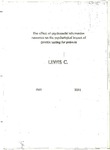The effect of psychosocial information resources on the psychological impact of genetic testing for patients
| dc.contributor.supervisor | Skirton, Heather | |
| dc.contributor.author | Lewis, Celine | |
| dc.contributor.other | School of Nursing and Midwifery | en_US |
| dc.date.accessioned | 2011-08-19T11:54:14Z | |
| dc.date.available | 2011-08-19T11:54:14Z | |
| dc.date.issued | 2011 | |
| dc.identifier | 10126950 | en_US |
| dc.identifier.uri | http://hdl.handle.net/10026.1/543 | |
| dc.description | Genet Test Mol Biomarkers. 2010 Dec;14(6):807-15. Epub 2010 Oct 12. Living without a diagnosis: the parental experience. Lewis C, Skirton H, Jones R.J Genet Couns. 2011 Feb;20(1):80-97. Epub 2010 Sep 29. Can we make assumptions about the psychosocial impact of living as a carrier, based on studies assessing the effects of carrier testing? Lewis C, Skirton H, Jones R. | en_US |
| dc.description.abstract |
The effect of psychosocial information resources on the psychological impact of genetic testing for patients Background: The genetic testing process has been shown to have a profound psychosocial impact on patients and families, yet research suggests that there is a lack of practical and helpful psychosocial information written to support decision-making. Ideally, this should be available for use both before and after genetic testing and should be easily accessed through genetic clinics. The development of pre-written leaflets or on-line resources which draw on the experiences and advice of families who have been through similar experiences, and are readily available through genetic clinics, might be one way of helping families make necessary adjustments. Aim: The aim of this study was to develop information resources for a) people undergoing carrier testing, and b) parents of children with undiagnosed conditions, and to pilot the use of these resources with service users. Methods: A systematic literature review was conducted to identify key themes to inform the content of the resources. To build on these findings, in-depth interviews were conducted with 11 people who had undergone carrier testing and 14 parents of children without a diagnosis. Interview data were analysed using the grounded theory method. A grey literature search of existing patient information was also conducted. These three phases informed the content of information resources. The development process also included input from genetic specialists, patient group representatives and interviewees. Finally, a pilot study was conducted through three genetic centres to assess the feasibility of a study testing the use of the resources. Findings: The participants in this study were striving for empowerment: carriers sought reproductive empowerment; parents developed empowerment strategies in order to advocate for their child. Moreover, a theory named ‘reconstructing the meaning of being a parent’ was constructed to describe the experience of parenting a child for whom no clear care pathway existed. The importance of providing timely information was identified as being a key factor in supporting parents during their search for a diagnosis. A new model was built to summarise the overarching experience of participants in this study. Conclusions: Empowerment was identified as a dynamic and multi-faceted construct. Health professionals and support groups can help facilitate the empowerment process through the provision of timely psychosocial information. This is particularly important in an age when patients are expected to take greater control than ever before over decisions affecting their healthcare. | en_US |
| dc.language.iso | en | en_US |
| dc.publisher | University of Plymouth | en_US |
| dc.subject | Genetic testing | en_US |
| dc.subject | Genetic counselling | |
| dc.subject | Education | |
| dc.subject | Patient information | |
| dc.subject | Psychosocial | |
| dc.subject | Mixed Methods | |
| dc.title | The effect of psychosocial information resources on the psychological impact of genetic testing for patients | en_US |
| dc.type | Thesis | |
| dc.identifier.doi | http://dx.doi.org/10.24382/1467 | |
| dc.identifier.doi | http://dx.doi.org/10.24382/1467 |
Files in this item
This item appears in the following Collection(s)
-
01 Research Theses Main Collection
Research Theses Main


